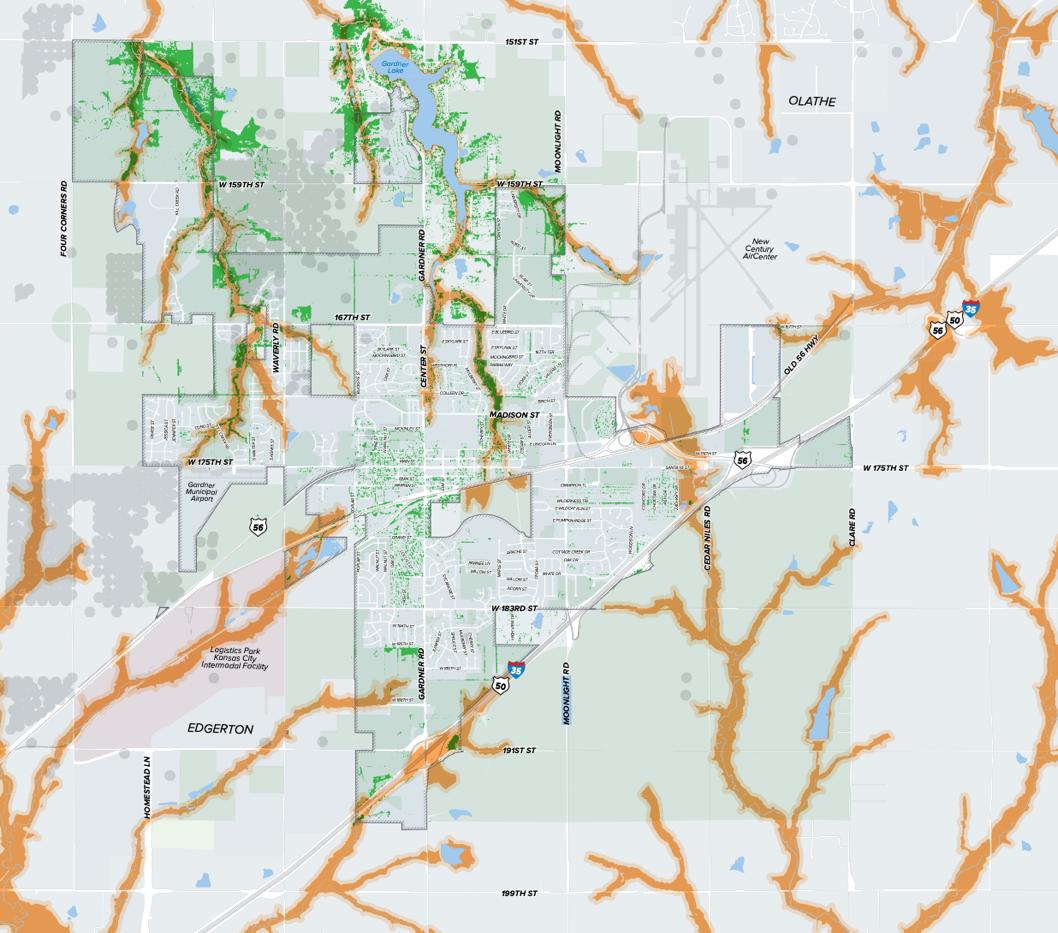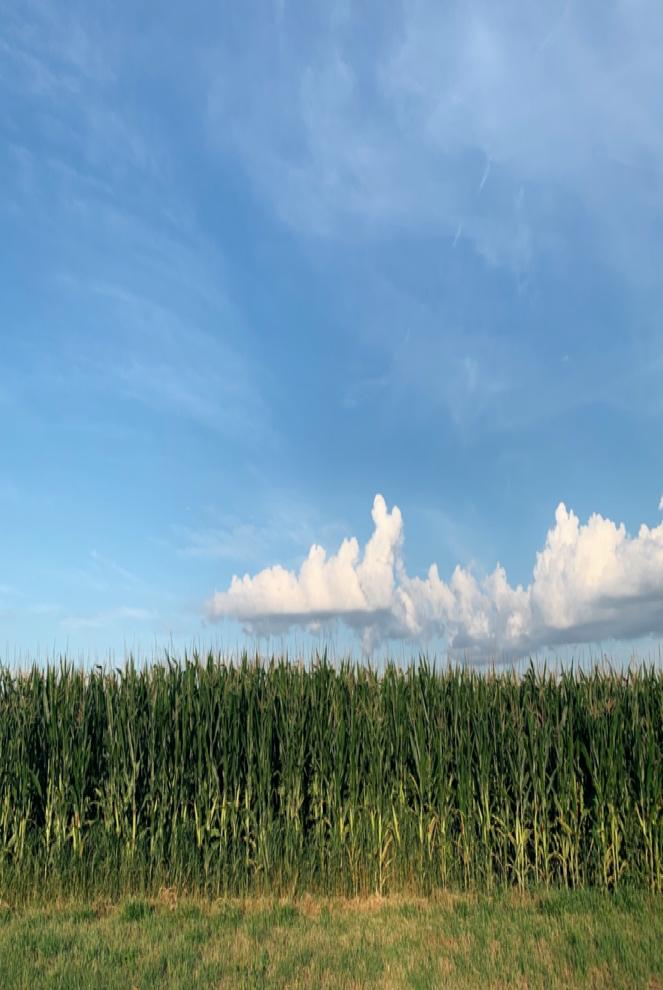
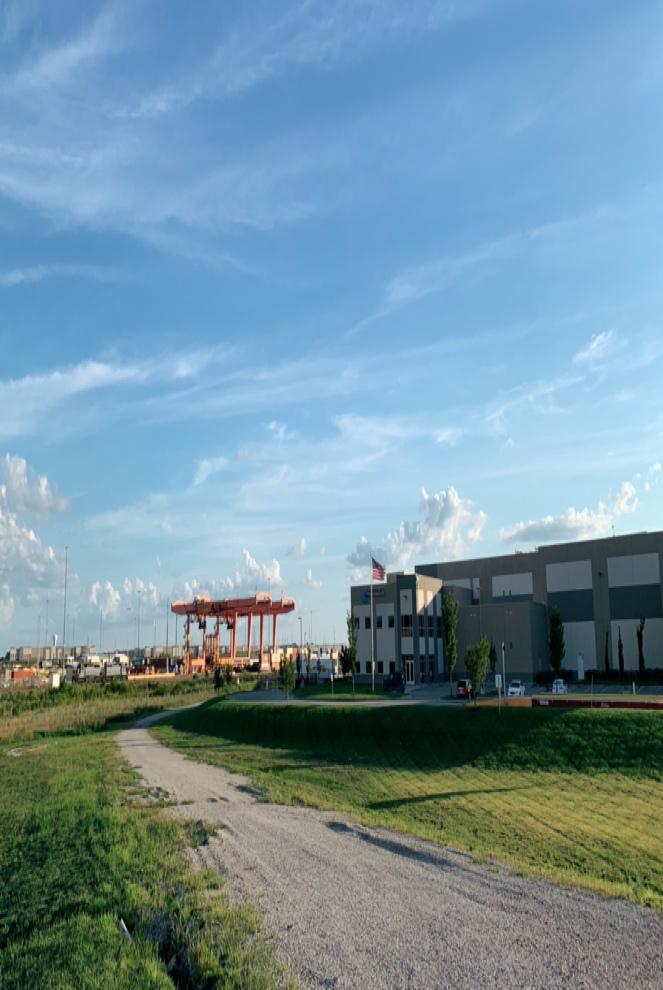
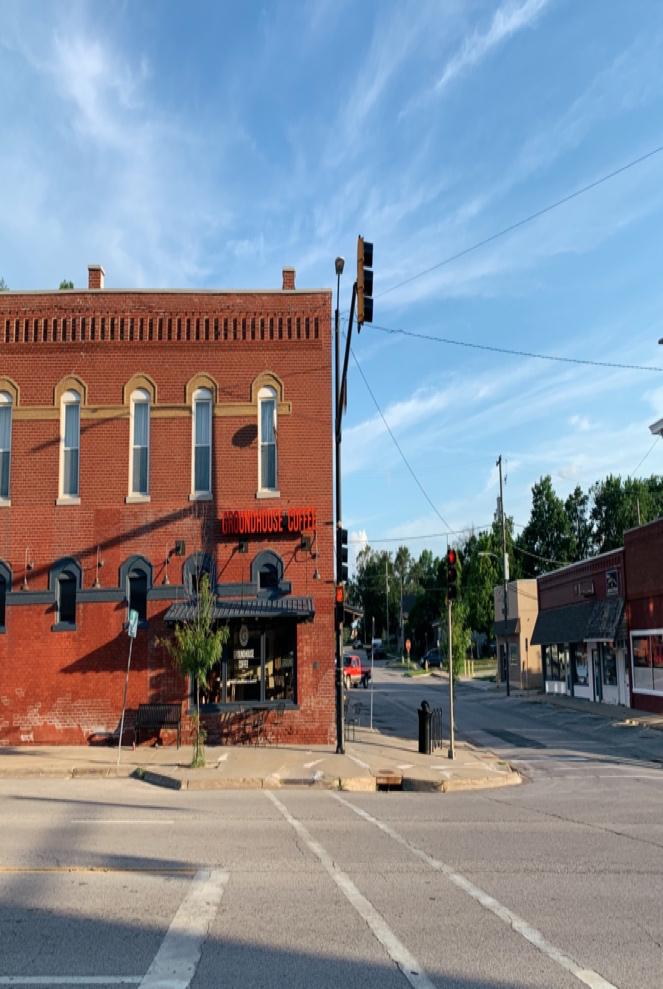
C ITY OF G ARDNER CLIMATE ADAPTATION & MITIGATION PLAN : 2020 ALEXANDRA PURVIS SMITH UBPL 502, SUMMER 2020
T ABLE OF C ONTENTS
Gardner, KS: Introduction to Gardner ................................................................................................. 3
Gardner, KS: Background ....................................................................................................................... 5
Gardner, KS: Environmental Context ................................................................................................... 6
Gardner, KS: Natural Hazards ............................................................................................................... 9
Gardner, KS: Climate Change ............................................................................................................. 10
Gardner, KS: GHG Emissions Inventory ............................................................................................. 11
Gardner, KS: Climate Change Mitigation ........................................................................................... 13
Gardner, KS: Climate Change Adaptation ......................................................................................... 18
Bibliography ........................................................................................................................................... 22
2
4
1
7
G ARDNER , KS: I NTRODUCTION TO G ARDNER
THE CITY OF GARDNER, KANSAS: “BLAZING NEW TRAILS”1
Gardner, Kansas is a small but quickly growing city in southwest Johnson County. While still surrounded by agricultural land, Gardner is only thirty miles from Kansas City, and is expanding rapidly thanks to economic growth, new industries, and population trends. At around ten square miles, Gardner is home to a growing population2, and in 2018 the U.S. Census estimated Gardner’s population to be 21,8713. The City of Gardner’s website states that the city “has become the third fastest growing city in Kansas, doubling in size in just a mere decade.”4 With a median age of 32 years, Gardner is a relatively young city where 65.4% of people in Gardner own their own home and the median household income is $71,945 (and trending upwards)
VULNERABLE POPULATIONS
Map of Gardner5
Despite these promising growth numbers, Gardner is also home to many vulnerable people. Estimates show that 4.34% of Gardner’s population are living at or below the poverty line – a group which is overwhelmingly young and female 6 . Information from the Gardner-Edgerton School district presents an additional window into vulnerability in Gardner: according to data published by Johnson County in 2016, 33.8% of students in the Gardner-Edgerton School District were receiving free or reduced cost lunches7. In recent years, the GardnerEdgerton School District has experienced a spike in homelessness among its students8: the latest numbers (from 2016) place the number of homeless students at 1119 .
“About Gardner ,” Gardner, Kansas , 2020, http://www.gardnerkansas.gov/discover/about-gardner.
2 “Gardner, Kansas Population 2020,” Gardner, Kansas Population 2020 (Demographics, Maps, Graphs), 2020, https://worldpopulationreview.com/us-cities/gardner-kspopulation/.

3 Ibid
“About Gardner ,” Gardner, Kansas , 2020, http://www.gardnerkansas.gov/discover/about-gardner.
5 “Google Maps,” accessed July 5, 2020, https://goo.gl/maps/R2TZhPWLf9mNbUhi9.
6 Ibid
“Community Health Assessment and Community Profile,” Community Health Assessment and Community Profile (2016), pp. 35-35.
8 Sam Zeff, “Student Homelessness Spikes In Rural And Urban Kansas City Metro,” November 12, 2014, https://www.kcur.org/education/2014-11-12/studenthomelessness-spikes-in-rural-and-urban-kansas-city-metro.
9 “Education for Homeless Children and Youth,” Education for Homeless Children and Youth (2016), pp. 1-1.
3
G ARDNER , KS: I NTRODUCTION T O G ARDNER
JOBS & ECONOMIC SECTORS
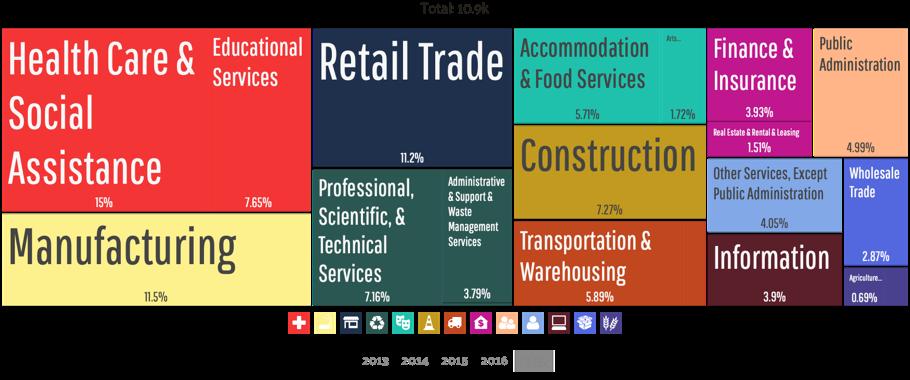
Like the population, Gardner’s economy has also experienced growth in recent years. The largest job sectors in Gardner are Health Care and Social Assistance (15%), Manufacturing (11.5%), and Retail (11.2%)10 The most common occupations of Gardner residents are management, office and administrative support occupations, sales occupations, and production occupations11 .
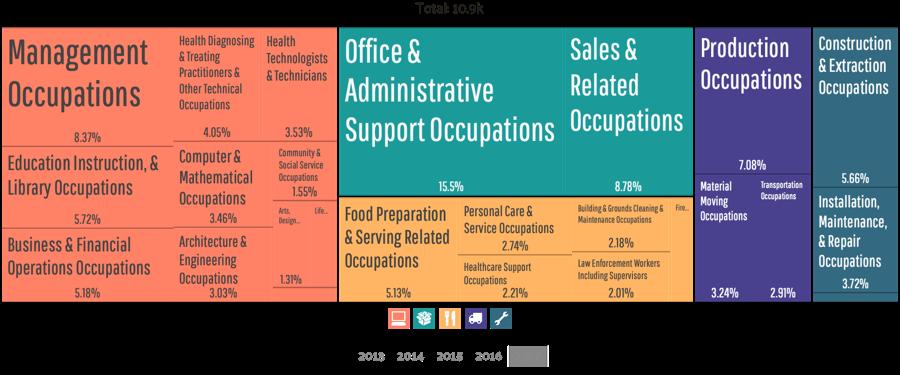
“Industries by Employer” from DataUSA.io
Near Gardner are the BNSF Intermodal & Logistics Park and the New Century Business Park. Gardner’s Economic Development plan (completed in June of 2014) heavily emphasizes the importance of these two economic drivers, and the many warehouses and jobs that they have brought to Gardner 12 However, the plan also emphasizes Gardner’s desire to strengthen other sectors of its economy and revitalize the downtown in order to attract new and different types of businesses, and diversify away from heavy industry and warehouses13 . This desire has been met with recent success; in 2019 Gardner made a deal for a new $200 million mixed-use development which will include hotels, retail stores, office spaces, restaurants, and single and multi-family housing units14
“Industries by Occupation” from DataUSA.io
Intermodal & warehouses in relation to Gardner, from logisticsparkkc.com
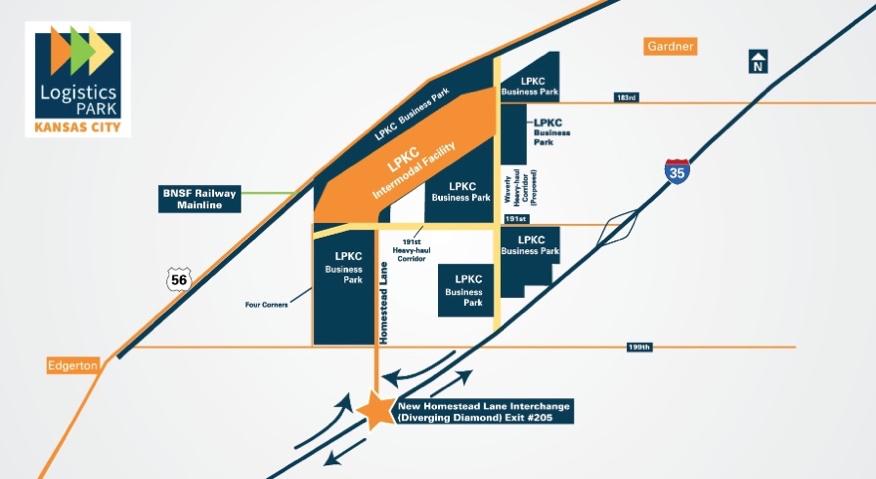
10
“Gardner, KS,” Data USA, 2020, https://datausa.io/profile/geo/gardner-ks/. 11 Ibid 12
“Economic Development Strategy,” Economic Development Strategy § (2014). 13 Ibid
14
Miranda Davis, “Gardner Prepares to Grow with Massive $200M Mixed-Use Development,” October 15, 2019, https://www.bizjournals.com/kansascity/news/2019/10/15/gardner-grata-mixed-use-development-agreement.html.
4
HISTORICAL CONTEXT
It is important to recognize that Gardner is built on land that was home to the Native American Kanza (or Kaw) tribe15 before they were forced out to make way for white settlers16 . The town of Gardner was founded on March 16, 1857, and was a part of the Free State movement that successfully worked to keep slavery out of the Territory of Kansas 17 Gardner’s town motto is “Blazing New Trails”, a reference to its historical site at the fork where westward-bound trails split off into the Oregon and California Trail and the Santa Fe Trail18 .
THE CITY OF GARDNER’S VISION TODAY
Gardner’s visioning statement, included in the 2014 Comprehensive Plan, describes the city as “a thriving community that continues to grow, with a high quality of life defined by its balance of traditional character and new development that collectively meet the needs of residents and businesses.” 20 The Comprehensive Plan envisions a future for Gardner where it is livable, surrounded by greenspace, with a tight-knit community of engaged citizens21 .
EXISTING PLANNING DOCUMENTS
To work towards creating this future, Gardner has developed its previously mentioned Comprehensive Plan and Economic Development Plan. Gardner is also included under Johnson County’s Hazard Mitigation Plan22 Recent planning efforts by the city have been focused on two area sub-plans: the I-35 & 175th Street Interchange Subarea Plan, and the I-35 & Gardner Road Interchange Subarea Plan.23 Currently, Gardner does not appear to have a climate plan or an initiative to create a climate plan.
15
“Native American Tribes of Kansas,” Kansas Indian Tribes and Languages, accessed July 6, 2020, http://www.native-languages.org/kansas.htm.
16 Beccy Tanner, “Native Americans: the First Kansans,” kansas (The Wichita Eagle, February 20, 2011), https://www.kansas.com/news/local/news-columns-blogs/thestory-of-kansas/article1053992.html.
17 “The History of Gardner,” Gardner Historical Museum, accessed July 6, 2020, https://gardnerhistoricalmuseum.com/gardner-history/.
18
“Gardner, KS,” Gardner History | Gardner, KS, accessed July 6, 2020, http://www.gardnerkansas.gov/discover/about-gardner/history.
19
“Johnson County, Kansas History and Genealogy,” Johnson County Kansas Genealogy, History, maps with Olathe, Lenexa, Shawnee, Merriam, De Soto, Edgerton, Gardner, Spring Hill, Stilwell, A. T. Andreas, Ed Blair, William G. Cutler, KS, maps, family, families, accessed July 6, 2020, http://www.hearthstonelegacy.com/johnson-county-kansas.htm.
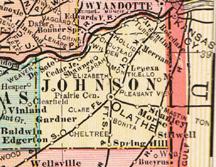
20 “Gardner, KS,” Gardner Comprehensive Plan, 2014, http://www.gardnerkansas.gov/development/economic-development/gardner-comprehensive-plan.
21 Ibid
22
“Mitigation Plan,” Johnson County Kansas, accessed July 6, 2020, https://www.jocogov.org/dept/emergency-management/emergency-management-program/countyemergency-plans/mitigation-plan.
23
“Gardner, KS,” Planning and Zoning | Gardner, KS, accessed July 6, 2020, http://www.gardnerkansas.gov/development/new-businesses/planning-and-zoning.
5 G
,
B
ARDNER
KS:
ACKGROUND
1911 Map of Johnson County19
G ARDNER , KS: E NVIRONMENTAL C ONTEXT
“…FLOODING, SEVERE STORMS WITH LARGE HAIL AND TORNADOES, BLIZZARDS, ICE STORMS, RELENTLESS WINDS, HEAT WAVES, AND DROUGHT ITS PEOPLE AND ECONOMIES ARE OFTEN AT THE MERCY OF SOME OF THE MOST DIVERSE AND EXTREME WEATHER HAZARDS ON THE PLANET. THESE EVENTS CAUSE SIGNIFICANT STRESS TO EXISTING INFRASTRUCTURE AND SOCIOECONOMIC SYSTEMS AND CAN RESULT IN SIGNIFICANT LOSS OF LIFE AND THE LOSS OF BILLIONS OF DOLLARS IN PROPERTY. ” 24
THE FOURTH NATIONAL CLIMATE ASSESSMENT (2018), DESCRIBING THE CLIMATE OF THE SOUTHERN GREAT PLAINS
24 Bartush, Bill, Kevin Kloesel, Jay Banner, David Brown, Jay Lemery, Xiaomao Lin, Cindy Loeffler, et al. “Fourth National Climate Assessment: Chapter 23: Southern Great Plains.” Fourth National Climate Assessment. 2018.
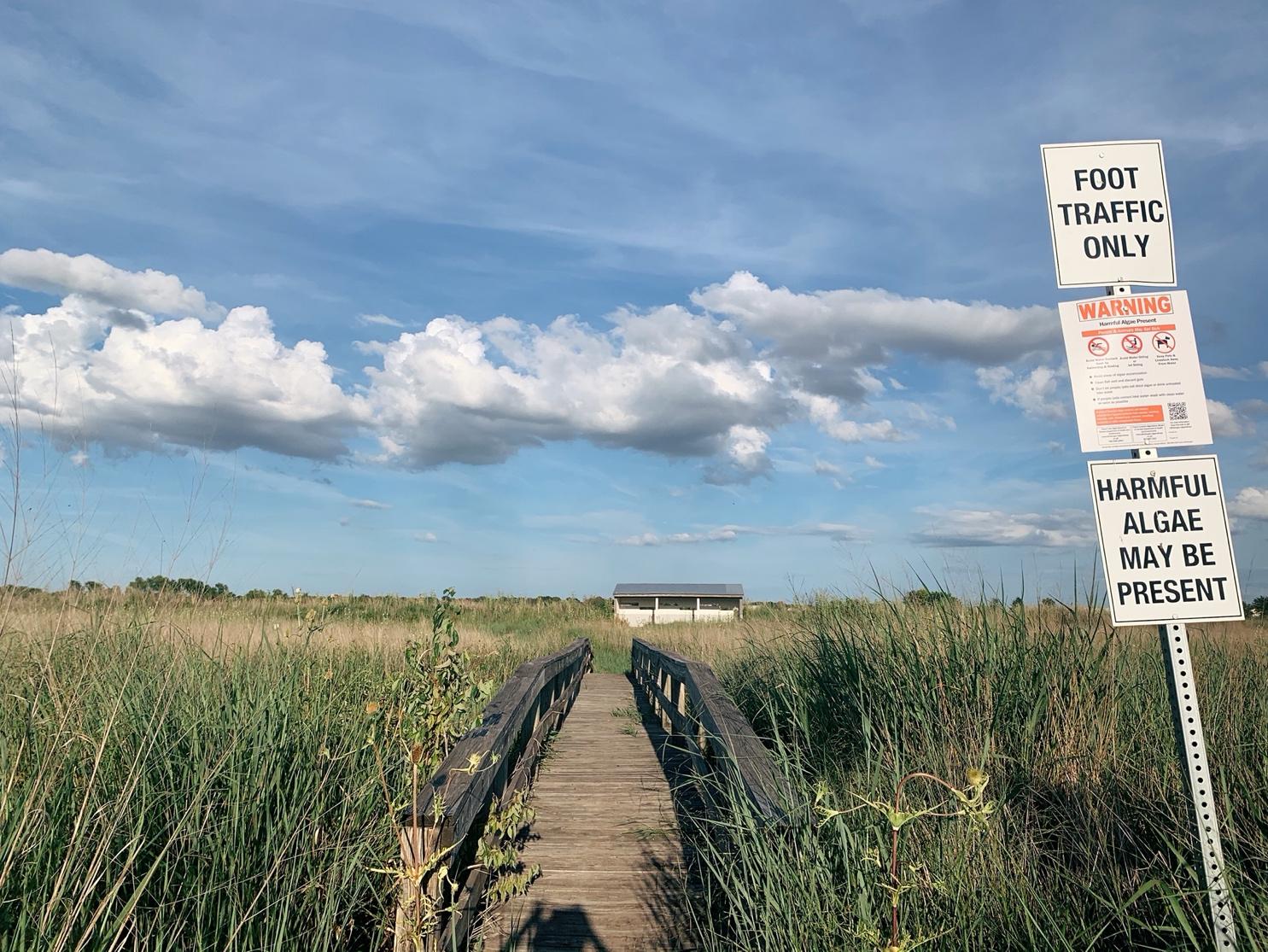
6
KCPL Prairie Wetland, Gardner KS
GARDNER’S ANNUAL WEATHER AVERAGES 25
GARDNER’S CLIMATE
Gardner lies at the northeastern edge of the Southern Great Plains region of the United States – a region known for its prairies and farmlands punctuated by tornadoes, droughts, and torrential thunderstorms. Gardner is no exception and the city experiences all four seasons Gardner receives a rainfall average of 39.31 inches annually, a snowfall average of 14.34 inches annually, and a wind-speed annual average of 18.25 mph.26
GARDNER’S LAKES, WETLANDS, & MUNICIPAL WATER
The city’s only lake is Gardner Lake – a 120-acre lake with a maximum depth of 40 feet – located north of the city27 Gardner’s municipal water supply is purchased from Hillsdale Lake, in nearby Miami County 28 Gardner is also home to a prairie wetland: the KCPL Wetland Park, part of the Big Bull Creek watershed29 . This prairie wetland serves the crucial function of providing a natural habitat for many different plant and animal species, and protecting the water quality of Gardner’s Bull Creek
Watershed30 Gardner Area Watershed Map31
25 “WeatherSpark.com,” Average Weather in Gardner, Kansas, United States, Year Round - Weather Spark, accessed July 12, 2020, https://weatherspark.com/y/9790/Average-Weather-in-Gardner-Kansas-United-States-Year-Round.

26 “Gardner, KS Weather,” USA.com, accessed July 12, 2020, http://www.usa.com/gardner-ks-weather.htm.
27 Parks and Tourism Kansas Department of Wildlife, “Gardner City Lake,” Gardner City Lake / Northeast Region / Fishing Locations - Public Waters / Where to Fish in Kansas / Fishing / KDWPT - KDWPT, accessed July 12, 2020, https://ksoutdoors.com/Fishing/Where-to-Fish-in-Kansas/Fishing-Locations-PublicWaters/Northeast-Region/Gardner-City-Lake.
28 “Gardner, KS,” Water Division | Gardner, KS, accessed July 12, 2020, http://www.gardnerkansas.gov/government/utilities-department/water-division. 29 “Gardner, KS,” Parks and Facilities | Gardner, KS, accessed July 12, 2020, http://www.gardnerkansas.gov/Home/Components/FacilityDirectory/FacilityDirectory/24/143. 30 Ibid
31 “AIMS Online Mapping,” Johnson County Online Mapping, accessed July 12, 2020, https://maps.jocogov.org/ims/.
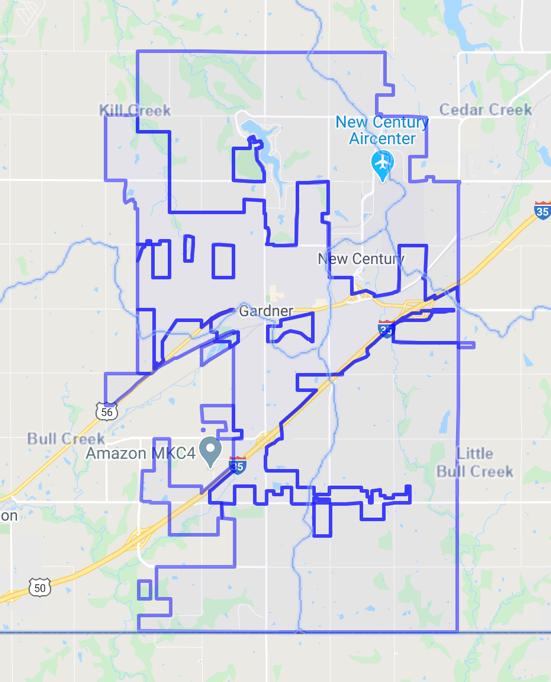
7 G ARDNER , KS: E NVIRONM
C
ENTAL
ONTEXT
G ARDNER , KS: GHG E MISSIONS I NVENTORY
GREENHOUSE GAS EMISSIONS INVENTORY BACKGROUND
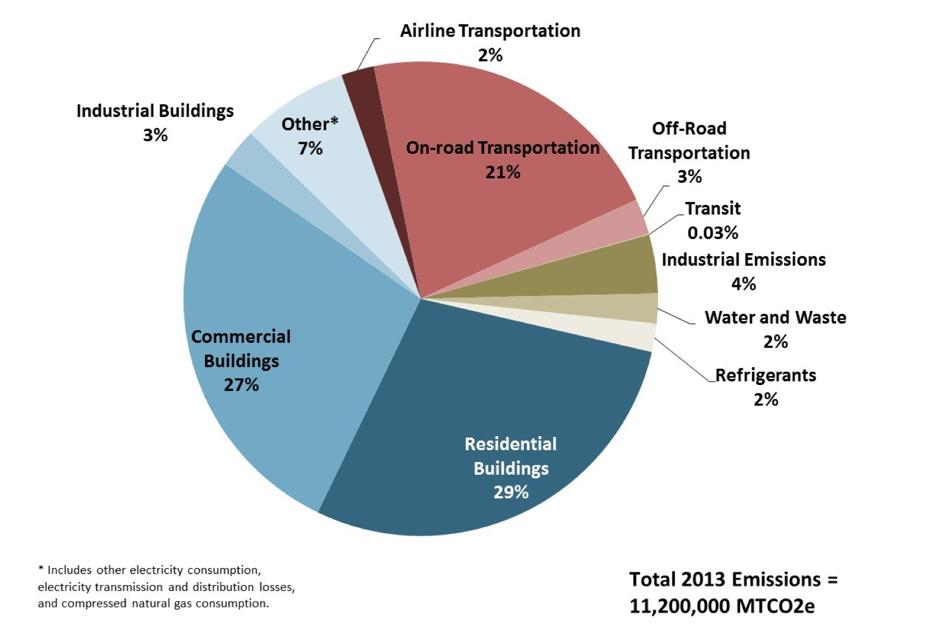
A GHG (Greenhouse Gas) emissions inventory is a process that investigates and reports on the GHG emissions of a community and the sources of those emissions. The inventory can then be used to target climate mitigation strategies and GHG reduction strategies to the most effective areas. 46 Currently, the city of Gardner has not undertaken its own emissions inventory. However, in 2014, Johnson County released a county-wide GHG Emissions Inventory report, breaking down the county’s emissions by sector and by energy source for 201347 The sectors of Commercial Buildings, Residential Buildings, and On-Road Transportation were the three largest contributors to the county’s emissions, and the largest energy source contributors were electricity, transportation, and natural gas 48 . The report found that the City of Gardner was responsible for 2% of the county’s overall emissions in 2013.49 Based on that percentage and the data published by Johnson County’s emissions inventory, Gardner’s GHG emissions can be estimated by taking 2% of the county’s emissions for each sector, and assuming that the emissions by energy source follow a similar breakdown to the county as a whole.

11
Johnson County GHG Emissions by Sector50
49 Ibid 50 Ibid 51
Johnson County GHG Emissions by Energy Source51
46
Michael Boswell, Adrienne Greve, and Tammy Seale, Climate Action Planning (Washington, DC: Island Press/Center for Resource Economics, 2019).
47
Johnson County and Brendle Group, “2013 Greenhouse Gas Inventory Update,” 2013 Greenhouse Gas Inventory Update (2014).
48 Ibid
Ibid
G ARDNER , KS: GHG E MISSIONS I NVENTORY
ESTIMATED GHG EMISSIONS INVENTORY FOR GARDNER, KS. BASED ON JOHNSON COUNTY EMISSIONS INVENTORY
DATA FROM 2013.
GREENHOUSE GAS EMISSIONS ESTIMATE
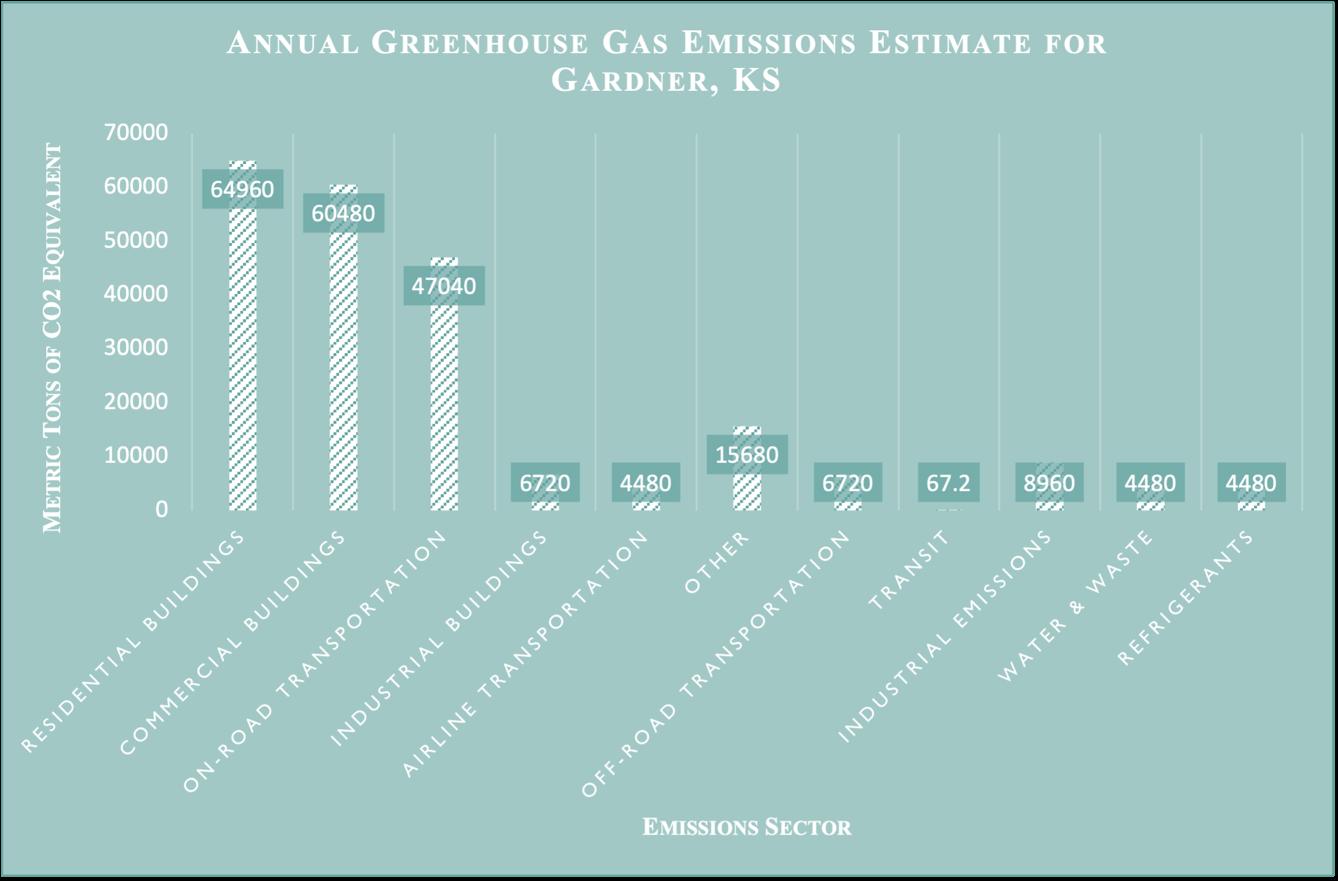
This chart is only an estimate of Gardner’s possible GHG emissions. The city will need to perform their own emissions inventory when they choose to create a municipal climate plan. However, this estimate does present a picture of Gardner’s emissions that can inform a starting point for climate mitigation and GHG emissions reduction recommendations. It is important to note that the city of Gardner does have a few notable differences from Johnson County as a whole, which may mean that certain emissions categories are a little higher or lower than shown in this estimate.
Ø Because of the nearby BNSF intermodal, Gardner has many warehouses which likely contribute to a higher percentage of Commercial Buildings emissions.
Ø The BNSF intermodal brings increased rail traffic to Gardner, which may result in a higher percentage of Off-Road Transportation emissions.
Ø Gardner is less densely residential than Johnson County as a whole, resulting in a possible lower percentage of Residential Building emissions.
12
SUSTAINABILITY IN GARDNER
The City of Gardner has already laid out its sustainability values in the city’s Comprehensive Plan. These values should help to shape the formation of the city’s climate mitigation goals. The values identified in Gardner’s Comprehensive Plan are:52
Ø LAND USE: Dense development & a revitalized downtown
Ø TRANSPORTATION & MOBILITY: Increase alternatives to car use & connect to regional transit networks
Ø PARKS, OPEN SPACE, & ENVIRONMENT: Prioritize maintaining & increasing greenspace, increase the urban forest, increase green infrastructure, & filter runoff to preserve water-body quality.
Ø COMMUNITY: Increase community access to infrastructure & increase community engagement.
Ø LOCAL FOOD PRODUCTION: Support local farmers & encourage urban gardens.
Ø ENERGY EFFICIENCY: Increase renewable energy sources for City buildings & encourage renewable energy in the community.
The GHG emissions inventory estimate for Gardner also provides insights regarding where the city’s climate mitigation goals should be focused. Given that the categories of Residential Buildings, Commercial Buildings, and On-Road Transportation are estimated to be overwhelmingly the highest contributors to Gardner’s carbon footprint, climate mitigation and GHG reduction goals should be targeted towards those areas. This will provide the most efficient path towards climate mitigation.
PLANNING
GARDNER
GARDNER’S PEDAL-TO-THE-METAL CLIMATE CHANGE MITIGATION GOALS
The following goals are ambitious. But the reality of earth’s warming climate leaves cities no choice other than to set ambitious goals. Because the IPCC has found that if countries, states, cities, and communities do not take immediate steps to effectively reduce GHG emissions by 2030, adaptation will become significantly more difficult and costly.53 This means that cities like Gardner have a responsibility to their citizens to set targeted,
52 “Gardner, KS,” Gardner Comprehensive Plan, 2014, http://www.gardnerkansas.gov/development/economic-development/gardner-comprehensive-plan. 53 IPCC, 2014: Summary for Policymakers. In: Climate Change 2014: Mitigation of Climate Change. Contribution of Work- ing Group III to the Fifth Assessment Report of the Intergovernmental Panel on Climate Change [Edenhofer, O., R. Pichs-Madruga, Y. Sokona, E. Farahani, S. Kadner, K. Seyboth, A. Adler, I. Baum, S. Brunner, P. Eickemeier, B. Kriemann, J. Savolainen, S. Schlömer, C. von Stechow, T. Zwickel and J.C. Minx (eds.)]. Cambridge University Press, Cambridge, United Kingdom and New York, NY, USA.
G
ARDNER , KS: C LIMATE C HANGE M ITIGATION
Ø GARDNER HOMEOWNERS Ø GARDNER BUSINESSES Ø EVERGY Ø LOCAL
CLIMATE
STAKEHOLDERS IN
Ø GARDNER’S CITY PLANNING COMMISSION Ø GARDNER MUNICIPAL GOVERNMENT Ø GARDNER RESIDENTS Ø GARDNER’S HOMELESS COMMUNITY
DEVELOPERS
ambitious goals to mitigate their carbon footprints. With this scientific reality in mind, the following goals will have a completion date of 2030 at the latest. They will be targeted to the three highest contributors to Gardner’s emissions. In 2020, at the beginning of this pivotal decade in human history, Gardner has the opportunity to become the climate leader in Johnson County and the Kansas City metro area. Gardner can set the standard for the region and become a stand-out example of municipal climate planning in a growing community.
CLIMATE MITIGATION WORK PLAN
To meet the following mitigation goals and policies, Gardner will need to take a few preceding steps:
Ø First, Gardner should create an Office / Department of Sustainability to oversee and manage climate planning, mitigation, adaptation, sustainability, and other related processes.
Ø Second, Gardner should initiate its own official GHG emissions inventory. The city will likely need to hire an outside consulting firm to accomplish this. The firm chosen should have previous experience with cities like Gardner – on the smaller side, with a growing population and economy.
Ø Third, Gardner should identify and begin to engage with key influential stakeholders in the city’s climate planning efforts.
Ø Fourth, Gardner should begin to engage with its community members about the critical importance of planning for climate change. Community engagement efforts should not only include soliciting opinions, needs, and values from the community (although including these things will be crucial for a successful climate plan). They should also include a community education campaign to help the Gardner community understand the specific consequences of climate change to their city and why it is so important to plan now.
Ø Fifth, Gardner should create its own official municipal Climate Mitigation & Adaptation Plan. This may be done in-house in the newly-created Sustainability office, or it may be done with the assistance of an outside consulting firm.
Ø Sixth, and finally, Gardner should partner with key stakeholders to meet its climate mitigation and GHG reduction goals. This may include utility companies, local businesses, local organizations, real estate developers, and more. Engaging with these stakeholders, partnering with them, and working with them to achieve Gardner’s policies will result in the most successful outcomes for the city’s mitigation goals.
14
G ARDNER , KS: C LIMATE C HANGE M ITIGATION
GOAL 1: CULTIVATE HIGH-EFFICIENCY BUILT ENVIRONMENTS
POLICY 1.1: ADOPT THE 2018 ICC GREEN BUILDING CODES
Gardner’s currently adopted municipal buildings codes were last updated in 2012.54 Adopting the 2018 ICC green building codes for all new and renovation construction projects will greatly increase the energy efficiency and resilience of Gardner’s built environment, both commercial and residential.55
Ø Timeframe: Immediate. Cost: Low.
POLICY 1.2: INCENTIVIZE NEW RESIDENTIAL CONSTRUCTION TO MEET TO PASSIVHAUS STANDARDS. PassivHaus is a research-backed set of building standards for extremely high energy efficiency in residential construction.56 These standards are ideally suited for Gardner’s environmental context and climate realities, and will substantially decrease Gardner’s Building Emissions.
Ø Timeframe: Immediate. Cost: Medium. POLICY 1.3: ADOPT ACHIEVING ZERO POLICIES FOR ALL NEW AND RENOVATION CONSTRUCTION
Achieving Zero is a set of policies for governments, including municipal governments, to help cities “phase out CO2 emissions in the built environment by 2040.” 57 Gardner should adopt these policies for all commercial, healthcare, industrial, multi-use, and multi-family construction.
Ø Timeframe: By 2030. Cost: Medium.
STRETCH POLICY 1.4: WORK TOWARDS ADOPTING ZERO CODE BUILDING STANDARDS
Gardner should take a phased approach to requiring increasingly efficient and low-carbon new and renovation construction, culminating in adopting Zero Code building standards. Zero Code is a set of building codes for zeronet-carbon buildings.58 While it is not practically feasible for Gardner to adopt this standard immediately, the city should set a goal-date by which they would be able to adopt Zero Code standards. One possibility is setting the goal of adopting Zero-Code standards by 2030, resulting in all new construction being net-zero by 2030 and beyond.
Ø Timeframe: By 2030. Cost: Medium.
54 http://www.gardnerkansas.gov/government/departments-and-divisions/building-and-inspections
55
“International Green Construction Code (IgCC),” ICC, June 13, 2019, https://www.iccsafe.org/products-and-services/i-codes/2018-i-codes/igcc/.
56 Passive House Institute, “Passive House Institute,” Passivhaus Institut, accessed July 19, 2020, https://passivehouse.com/02_informations/01_whatisapassivehouse/01_whatisapassivehouse.htm.
57 “About,” Achieving Zero, 2018, https://achieving-zero.org/about/.
58 “ZERO Code,” ZERO Code, 2018, http://zero-code.org/zero-code/.
15
G ARDNER , KS: C LIMATE C HANGE M ITIGATION
GOAL 2: INVEST IN RENEWABLE ENERGY
POLICY 2.1: PARTNER WITH AREA POWER AND UTILITY COMPANIES TO ENSURE THAT WIND POWER IS AN OPTION FOR GARDNER RESIDENTS
In some cities near Gardner, residents and businesses can choose a wind or solar subscription option to support renewable energy sources in their area.59 Gardner should ensure that their residents have this option to choose renewable energy.
Ø Timeframe: Immediate. Cost: Low.
POLICY 2.2: INCENTIVIZE RESIDENTS TO CHOOSE A WIND AND / OR SOLAR SUBSCRIPTION OPTIONS.
To continue to prioritize renewable energy sources, Gardner should partner with local utility companies to create an incentive program to encourage the choice of investing in renewable energy60. This should be open to businesses and all residents, regardless of income.
Ø Timeframe: Immediate. Cost: Medium.
POLICY 2.3: INCENTIVIZE RENEWABLE ENERGY SOURCE INSTALLATION FOR HOMES AND BUSINESSES.
Gardner should work with local utility companies to incentivize residents and businesses to choose to install solar panels61 or wind turbines62. Gardner should work towards the goal of ensuring that choosing solar panels is cost-competitive for businesses and residents.
Ø Timeframe: 2025. Cost: Medium.
STRETCH POLICY 2.4: WORK TOWARDS REQUIRING SOLAR PANELS ON ALL NEW COMMERCIAL, HEALTHCARE, MULTI-USE, AND MULTI-FAMILY CONSTRUCTION
As part of its building codes amendments and municipal incentive programs, Gardner should, by 2030, require63 that all new commercial, multi-use, and multi-family construction include solar panels.
Ø Timeframe: 2025. Cost: Medium.
STRETCH POLICY 2.5: WORK TOWARDS 100% RENEWABLE ENERGY.
Following the example of cities like Rock Port, Missouri,64 Gardner should develop an action plan to use a combination of wind turbines and solar panels to become power by 100% renewable energy sources by 2040.
Ø Timeframe: 2040. Cost: Initially high, with long-term payoff.
59
Evergy, “Subscription Programs,” evergy.com, accessed July 19, 2020, https://www.evergy.com/smart-energy/renewable-resources/subscription-programs.
60
“City Climate Policy,” Center for Climate and Energy Solutions, June 7, 2019, https://www.c2es.org/content/city-climate-policy/. 61 Ibid
62
Joakim Kaminsky, “Windmills in the City,” Latest News, 2017, https://www.smartcitiesdive.com/ex/sustainablecitiescollective/windmills-city/8807/.
63
“City Climate Policy,” Center for Climate and Energy Solutions, June 7, 2019, https://www.c2es.org/content/city-climate-policy/.
64
“The 4 Cities That Use the Most Wind Energy,” The 4 Cities That Use the Most Wind Energy, accessed July 19, 2020, https://www.arcadia.com/energy-101/energysources/the-4-cities-that-use-the-most-wind-energy/.
16
G ARDNER , KS: C LIMATE C HANGE M ITIGATION
GOAL 3: REDUCE & OFFSET ON & OFF ROAD TRANSPORTATION EMISSIONS
POLICY 3.1: PRIORITIZE DENSE DEVELOPMENT
In order to enable community members to utilize transportation options other than personal cars, Gardner should ensure that any new development (in any sector) meets density levels sufficient to support public transit and bike infrastructure. This should include prioritization of infill and multi-use developments.
Ø Timeframe: Immediate. Cost: Low.
POLICY 3.2: INCREASE BIKE INFRASTRUCTURE.
Also in keeping with stated values and goals in the city’s comprehensive plan,65 Gardner should increase bike infrastructure to encourage residents to choose alternatives to personal vehicles, and to make cycling a viable alternative. This infrastructure should include bike paths, bike lanes, buffer lanes, traffic-calming strategies, and additional forms of bike infrastructure.66
Ø Timeframe: By 2022. Cost: Low.
POLICY 3.3: INCREASE PUBLIC TRANSIT OPTIONS.
In keeping with stated values and goals in the city’s comprehensive plan,67 Gardner should increase public transit options. This will help to reduce reliance on personal vehicles, thereby reducing the city’s emissions. This may likely take the form of city busses, with would have the additional benefit of increasing connectivity to KC Metro transit – another stated goal of the Comprehensive Plan.
Ø Timeframe: By 2025. Cost: High.
STRETCH
POLICY 3.4: IMPLEMENT CARBON SINKS TO OFFSET RAIL & FREIGHT TRAFFIC
In addition to the nearby BNSF Intermodal and many train tracks, Gardner also has two highways running through city limits. This results in significant emissions from rail and freight sources. While Gardner cannot necessarily prevent the initial emissions from rail and freight sources, Gardner can implement carbon sinks to offset these emissions. To accomplish this, Gardner should increase the presence of native prairie grasses, the city’s urban forest, and additional greenspace to provide carbon sinks that will entirely offset rail and freight emissions
Ø Timeframe: By 2030. Cost: Medium.
65
“Gardner, KS,” Gardner Comprehensive Plan, 2014, http://www.gardnerkansas.gov/development/economic-development/gardner-comprehensive-plan.
66
“Essential Guide to Bike Infrastructure,” Reliance Foundry Co. Ltd, October 23, 2019, https://www.reliance-foundry.com/blog/bikeways-bike-infrastructure.
67
“Gardner, KS,” Gardner Comprehensive Plan, 2014, http://www.gardnerkansas.gov/development/economic-development/gardner-comprehensive-plan.
17
G ARDNER , KS: C LIMATE C HANGE A DAPTATION
CLIMATE ADAPTATION IN GARDNER
As Gardner plans for climate change adaptation, its goals and policies must be tailored to suit the specific challenges the city will face as the climate warms. As noted earlier in this document, Gardner will face much hotter temperatures throughout the year and more frequent torrential storms. 68 These conditions will threaten Gardner’s infrastructure.69 Therefore, the following goals and policies are targeted to address these projections.
CLIMATE ADAPTATION WORK PLAN
To meet the following adaptation goals and policies, Gardner will need to take a few preceding steps:
Ø First, Gardner must conduct a survey of the existing scientific literature that addresses climate projections for Gardner’s region of the United States, the Southern Great Plains. Gardner should identify the key outcomes of climate change for its geographic and environmental context.
Ø Second, Gardner should identify the areas where, as a municipality, it can effectually implement adaptation techniques.
Ø Third, using the projections it identifies Gardner should set Adaptation Goals targeted to build a resilient city.
Ø Fourth, it will be helpful for Gardner to identify any overlapping work and / or benefits between the city’s mitigation policies, adaptation policies, and existing projects. This will help Gardner implement the goals as efficiently as possible. For example:
Ø Bike infrastructure & permeable pavement: in Kansas, summer roadwork to repair winter damage is an annual given. Instead of repairing roads with traditional paving materials, this could become an annual opportunity to repair the city’s roads with permeable pavement and to add in bike infrastructure.
Ø Transitioning to renewable energy sources: increased use of AC (due to increasing heat) stresses the electric grid.70 There may be an opportunity to upgrade existing grid infrastructure while transitioning to renewables.
Ø Native plants & rain gardens: these serve the function of providing carbon sinks and also increasing flood resilience.71
Ø Urban canopy & flood resilience: increasing the urban canopy not only reduces the urban heat island effect, but it also increases resilience to stormwater and flash floods.72 A tree-planting program could be targeted to fulfill these two purposes at once.
68 Bartush, Bill, Kevin Kloesel, Jay Banner, David Brown, Jay Lemery, Xiaomao Lin, Cindy Loeffler, et al. “Fourth National Climate Assessment: Chapter 23: Southern Great Plains.” Fourth National Climate Assessment. 2018.
69 Ibid
70
Center for Climate And Energy Solutions, “Policy Options For Climate-Resilient Infrastructure,” C2ES, January 2018, https://www.c2es.org/site/assets/uploads/2018/01/policy-options-for-resilient-infrastructure-01-2018.pdf.
71 Center for Climate And Energy Solutions, “Policy Options For Climate-Resilient Infrastructure,” C2ES, January 2018, https://www.c2es.org/site/assets/uploads/2018/01/policy-options-for-resilient-infrastructure-01-2018.pdf.
72 Ibid
18
G ARDNER , KS: C LIMATE C HANGE A DAPTATION
GOAL 1: ADAPT FOR HEAT RESILIENCE
POLICY 1.1: GARDNER SHOULD CREATE A HEAT WAVE WARNING SYSTEM
Climate change will bring much higher summer temperatures to Gardner, and the city must ensure that it’s community is protected from heat and heat-related illnesses. Following the example of communities like Olmstead County (MN), Gardner should create a warning system that can be deployed to warn city residents of heat waves and dangerous heat conditions.73 Gardner must ensure that the warning system will reach even the most vulnerable members of the community, so that residents can find air-conditioned shelter from the heat.
Ø Timeframe: Immediate. Cost: Low.
POLICY 1.2: GARDNER SHOULD INVEST IN PUBLIC SPACES THAT PROVIDE RELIEF FROM HEAT Building on the preceding policy, Gardner should also increase access to and availability of cooled public spaces, such as libraries, pools, recreation centers, and other public facilities 74 For residents without air-conditioning, these public spaces will provide invaluable relief from heat waves. This may require expanding existing public spaces, and should include outreach efforts to the Gardner Community to ensure that residents know where to go.75
Ø Timeframe: Immediate. Cost: Medium.
POLICY 1.3: GARDNER SHOULD UTILIZE GREEN & COOL ROOFS. With higher summer temperatures in its future, Gardner must take steps to reduce the urban heat island effect in its community. To this end, Gardner should require that all new construction utilize cool roofs.76 Additionally, Gardner should create an incentive program for homeowners that will encourage replacing traditional roofs with cool roofs. Gardner should also create an incentive program for all new and renovation construction to encourage usage of green roofs where possible.77 With cool roofs as a baseline, and green roofs encouraged, this will help to reduce heat trapping surfaces throughout the city.78
Ø Timeframe: Immediate. Cost: Low – Medium. 73 “U.S. Climate Resilience Toolkit,” accessed July 24, 2020, https://toolkit.climate.gov/case-studies/bracing-heat. 74 Ibid 75 Ibid 76 Center for Climate and Energy Solutions, “Resilience Strategies for Extreme Heat,” C2ES, November 2017, https://www.c2es.org/site/assets/uploads/2017/11/resilience-strategies-for-extreme-heat.pdf. 77 Ibid 78 Ibid
19
POLICY
1.4:
G ARDNER , KS: C LIMATE C HANGE A DAPTATION
INCREASE THE URBAN CANOPY
Another important step towards reducing the urban heat island effect in Gardner will be increasing the city’s urban canopy.79 Currently, Gardner’s downtown has almost no trees, and the new warehouse districts have very few trees as well. Gardner should establish a tree-planting and tree-care program to increase the city’s urban canopy. This program should include planting and caring for trees in city-owned and public spaces, and should also include incentives for homeowners, landlords, and developers to preserve and plant trees on private property and new developments. (Note: urban trees will also have the co-benefit of assisting with stormwater retention.)
Ø Timeframe: Immediate. Cost: Low – Medium.
POLICY 1.5:
UTILIZE COOL PAVEMENTS
To reduce the heat trapping potential of the city’s roads, Gardner should also begin the process of incorporating cool (high albedo) pavements on all city streets.80 Additionally, Gardner should require that all new development use cool pavements. Gardner may also want to create an incentive or tax break program for property owners who choose to repave traditional paving with cools pavements.
Ø Timeframe: By 2025. Cost: Medium.
GOAL 2: ADAPT FOR INFRASTRUCTURE RESILIENCE
POLICY 2.1:
UTILIZE CLIMATE PROJECTIONS FOR INFRASTRUCTURE AND DEVELOPMENT
DECISIONS. As Gardner grows, the city should make sure that it’s infrastructure and development decisions take into account the effects of climate change for its geographic region.81 Gardner should identify areas where its climate data does not incorporate climate change projections and update that to accurately reflect the local future climate.82
Ø Timeframe: Immediate. Cost: Low.
POLICY 2.2: PRIORITIZE UPGRADING & REPLACING AGING, DEGRADED INFRASTRUCTURE
Gardner should begin shoring up the city’s infrastructure to ensure that it will be able to withstand the effects of climate change. The city should assess the state of its existing infrastructure, then create a plan for repairing, replacing, and upgrading infrastructure as needed. State loans and grants may be available to fund this endeavor.83
Ø Timeframe: Immediate. Cost: High.
79 Center for Climate and Energy Solutions, “Resilience Strategies for Extreme Heat,” C2ES, November 2017, https://www.c2es.org/site/assets/uploads/2017/11/resilience-strategies-for-extreme-heat.pdf.
80 Berkley Lab, “Cool Pavements,” HeatIsland (Berkely Lab), accessed July 26, 2020, https://heatisland.lbl.gov/coolscience/cool-pavements.
81 Center for Climate And Energy Solutions, “Policy Options For Climate-Resilient Infrastructure,” C2ES, January 2018, https://www.c2es.org/site/assets/uploads/2018/01/policy-options-for-resilient-infrastructure-01-2018.pdf.
82 Ibid
83 State of Kansas - Office of Information Technology Services, “State Revolving Fund,” Kansas Department of Administration, accessed July 26, 2020, https://www.admin.ks.gov/offices/oar/state-revolving-fund.
20
G ARDNER , KS: C LIMATE C HANGE A DAPTATION
GOAL 3: ADAPT FOR STORM & FLOOD RESILIENCE
POLICY 3.1: AVOID DEVELOPMENT IN FLOODPLAINS
Given Gardner’s location at the intersection of three different watersheds, the city has no shortage of floodplains.84 To increase the city’s flood resilience, Gardner should ensure that it does not develop in its floodplains. Instead, Gardner should preserve that land for parks and greenspaces.
Ø Timeframe: Immediate. Cost: Low-Medium.
POLICY 3.2:
UTILIZE PERMEABLE PAVEMENTS.
To compliment its cool pavement policy and to increase stormwater and flood resilience, Gardner should also switch to using permeable pavement on all city streets.85 Additionally, all new development should be required to use permeable pavement. (Note: cool pavements and permeable pavements are not mutually exclusive, and many permeable pavement materials also qualify as cool pavements.86)
Ø Timeframe: By 2025. Cost: Medium.
POLICY 3.4:
STRATEGICALLY UTILIZE GREEN INFRASTRUCTURE STRATEGIES WHERE APPLICABLE.
Gardner should strategically utilize green infrastructure techniques such as bioswales, rain gardens, and street trees to combat the negative effects of stormwater runoff and to increase storm and flood resilience.87 Strategically placed bioswales can successfully absorb and filter large amounts stormwater runoff.88 Rain gardens are gardens planted with native plants that can quickly absorb stormwater, giving it somewhere to go.89 And street trees –particularly large, established trees – are effective at catching rainfall in their leaves and absorbing stormwater through their root systems.90 Gardner should identify areas throughout the city where stormwater runoff may be an issue and may even lead to flash flooding, and deploy these strategies to counter negative impacts from stormwater. This may include programs and incentives to replace grass lawns with rain gardens, requirements to preserve large, established trees in developing areas, and strategic construction of bioswales in areas where runoff from streets and / or parking lots is known to be an issue.
Ø Timeframe: Immediate. Cost: Medium.
84 AIMS Online Mapping,” Johnson County Online Mapping, accessed July 12, 2020, https://maps.jocogov.org/ims/.
85
“Permeable Pavement,” Green Building Alliance, accessed July 26, 2020, https://www.go-gba.org/resources/green-building-methods/permeable-pavements/.
86
“Cool Pavement,” Urban Green Up, accessed July 26, 2020, https://www.urbangreenup.eu/solutions/cool-pavement.kl.
87 Center for Climate and Energy Solutions, “Resilience Strategies for Flash Flooding,” C2ES, February 2018, https://www.c2es.org/site/assets/uploads/2018/02/resilience-strategies-for-flash-flooding.pdf. 88 Ibid 89 Ibid 90 Ibid
21
“About Gardner .” Gardner, Kansas , 2020. http://www.gardnerkansas.gov/discover/about-gardner.
“About.” Achieving Zero, 2018. https://achieving-zero.org/about/.
“AIMS Online Mapping.” Johnson County Online Mapping. Accessed July 12, 2020. https://maps.jocogov.org/ims/.
Bartush, Bill, Kevin Kloesel, Jay Banner, David Brown, Jay Lemery, Xiaomao Lin, Cindy
Berkley Lab. “Cool Pavements.” HeatIsland. Berkely Lab. Accessed July 26, 2020. https://heatisland.lbl.gov/coolscience/cool-pavements.
Boswell, Michael, Adrienne Greve, and Tammy Seale. Climate Action Planning. Washington, DC: Island Press/Center for Resource Economics, 2019.
Center for Climate And Energy Solutions. “Policy Options For Climate-Resilient Infrastructure.” C2ES, January 2018. https://www.c2es.org/site/assets/uploads/2018/01/policy-options-for-resilientinfrastructure-01-2018.pdf.
Center for Climate and Energy Solutions. “Resilience Strategies for Extreme Heat.” C2ES, November 2017. https://www.c2es.org/site/assets/uploads/2017/11/resilience-strategies-for-extreme-heat.pdf.
Center for Climate and Energy Solutions. “Resilience Strategies for Flash Flooding.” C2ES, February 2018. https://www.c2es.org/site/assets/uploads/2018/02/resilience-strategies-for-flash-flooding.pdf.
“City Climate Policy.” Center for Climate and Energy Solutions, June 7, 2019. https://www.c2es.org/content/city-climate-policy/.
“Cool Pavement.” Urban Green Up. Accessed July 26, 2020. https://www.urbangreenup.eu/solutions/coolpavement.kl.
“County Emergency Plans.” Johnson County Kansas, November 7, 2019. https://www.jocogov.org/dept/emergency-management/emergency-management-program/countyemergency-plans.
Davis, Miranda. “Gardner Prepares to Grow with Massive $200M Mixed-Use Development,” October 15, 2019. https://www.bizjournals.com/kansascity/news/2019/10/15/gardner-grata-mixed-use-developmentagreement.html.
Department of Education, Education for Homeless Children and Youth § (2016).
Economic Development, Economic Development Strategy § (2014).
22 B
IBLIOGRAPHY
“Essential Guide to Bike Infrastructure.” Reliance Foundry Co. Ltd, October 23, 2019. https://www.reliancefoundry.com/blog/bikeways-bike-infrastructure.
Evergy. “Subscription Programs.” evergy.com. Accessed July 19, 2020. https://www.evergy.com/smartenergy/renewable-resources/subscription-programs.
“Exploring Future Climate Projections.” The Climate Explorer. noaa.maps.arcgis.com . Accessed July 12, 2020. http://noaa.maps.arcgis.com/apps/MapJournal/index.html?appid=92260a6bcf154d72bab62e50231e64c8.
“Gardner, Kansas Population 2020.” Gardner, Kansas Population 2020 (Demographics, Maps, Graphs), 2020. https://worldpopulationreview.com/us-cities/gardner-ks-population/.
“Gardner, KS Natural Disasters and Weather Extremes.” Accessed July 12, 2020. http://www.usa.com/gardnerks-natural-disasters-extremes.htm.
“Gardner, KS Weather.” USA.com. Accessed July 12, 2020. http://www.usa.com/gardner-ks-weather.htm.
“Gardner, KS.” Building and Inspections | Gardner, KS. Accessed July 19, 2020. http://www.gardnerkansas.gov/government/departments-and-divisions/building-and-inspections.
“Gardner, KS.” Data USA, 2020. https://datausa.io/profile/geo/gardner-ks/.
“Gardner, KS.” Gardner Comprehensive Plan, 2014. http://www.gardnerkansas.gov/development/economicdevelopment/gardner-comprehensive-plan.
“Gardner, KS.” Gardner History | Gardner, KS. Accessed July 6, 2020. http://www.gardnerkansas.gov/discover/about-gardner/history.
“Gardner, KS.” Parks and Facilities | Gardner, KS. Accessed July 12, 2020. http://www.gardnerkansas.gov/Home/Components/FacilityDirectory/FacilityDirectory/24/143.
“Gardner, KS.” Planning and Zoning | Gardner, KS. Accessed July 6, 2020. http://www.gardnerkansas.gov/development/new-businesses/planning-and-zoning.
“Gardner, KS.” Water Division | Gardner, KS. Accessed July 12, 2020. http://www.gardnerkansas.gov/government/utilities-department/water-division.
“Google Maps.” Accessed July 5, 2020. https://goo.gl/maps/R2TZhPWLf9mNbUhi9.
Health & Environment, Community Health Assessment and Community Profile § (2016).
Institute, Passive House. “Passive House Institute.” Passivhaus Institut. Accessed July 19, 2020. https://passivehouse.com/02_informations/01_whatisapassivehouse/01_whatisapassivehouse.htm.
“International Green Construction Code (IgCC).” ICC, June 13, 2019. https://www.iccsafe.org/products-andservices/i-codes/2018-i-codes/igcc/.
IPCC, 2014: Summary for Policymakers. In: Climate Change 2014: Mitigation of Climate Change. Contribution of Work- ing Group III to the Fifth Assessment Report of the Intergovernmental Panel on Climate
23
Change [Edenhofer, O., R. Pichs-Madruga, Y. Sokona, E. Farahani, S. Kadner, K. Seyboth, A. Adler, I. Baum, S. Brunner, P. Eickemeier, B. Kriemann, J. Savolainen, S. Schlömer, C. von Stechow, T. Zwickel and J.C. Minx (eds.)]. Cambridge University Press, Cambridge, United Kingdom and New York, NY, USA.
Johnson County, and Brendle Group, 2013 GREENHOUSE GAS INVENTORY UPDATE § (2014).
“Johnson County, Kansas History and Genealogy.” Johnson County Kansas Genealogy, History, maps with Olathe, Lenexa, Shawnee, Merriam, De Soto, Edgerton, Gardner, Spring Hill, Stilwell, A. T. Andreas, Ed Blair, William G. Cutler, KS, maps, family, families. Accessed July 6, 2020. http://www.hearthstonelegacy.com/johnson-county-kansas.htm.
Kaminsky, Joakim. “Windmills in the City.” Latest News, 2017. https://www.smartcitiesdive.com/ex/sustainablecitiescollective/windmills-city/8807/.
Kansas Department of Wildlife, Parks and Tourism. “Gardner City Lake.” Gardner City Lake / Northeast Region / Fishing Locations - Public Waters / Where to Fish in Kansas / Fishing / KDWPT - KDWPT. Accessed July 12, 2020. https://ksoutdoors.com/Fishing/Where-to-Fish-in-Kansas/Fishing-LocationsPublic-Waters/Northeast-Region/Gardner-City-Lake.
Loeffler, et al. “Fourth National Climate Assessment: Chapter 23: Southern Great Plains.” Fourth National Climate Assessment . Global Change Research Program, Washington, DC, USA, 2018. https://nca2018.globalchange.gov/chapter/23/.
“Maps & Site Plans.” Logistics Park Kansas City. Accessed July 5, 2020. http://www.logisticsparkkc.com/locate-here-ship-everywhere/maps-site-plans/.
“Meeting the 2030 Challenge,” 2018. https://architecture2030.org/2030_challenges/2030-challenge/.
“Mitigation Plan.” Johnson County Kansas. Accessed July 6, 2020. https://www.jocogov.org/dept/emergencymanagement/emergency-management-program/county-emergency-plans/mitigation-plan.
“Native American Tribes of Kansas.” Kansas Indian Tribes and Languages. Accessed July 6, 2020. http://www.native-languages.org/kansas.htm.
“Permeable Pavement.” Green Building Alliance. Accessed July 26, 2020. https://www.gogba.org/resources/green-building-methods/permeable-pavements/.
State of Kansas - Office of Information Technology Services. “State Revolving Fund.” Kansas Department of Administration. Accessed July 26, 2020. https://www.admin.ks.gov/offices/oar/state-revolving-fund.
Tanner, Beccy. “Native Americans: the First Kansans.” kansas. The Wichita Eagle, February 20, 2011. https://www.kansas.com/news/local/news-columns-blogs/the-story-of-kansas/article1053992.html.
The 4 Cities That Use the Most Wind Energy. Accessed July 19, 2020. https://www.arcadia.com/energy101/energy-sources/the-4-cities-that-use-the-most-wind-energy/.
“The History of Gardner.” Gardner Historical Museum. Accessed July 6, 2020. https://gardnerhistoricalmuseum.com/gardner-history/.
24
“U.S. Climate Resilience Toolkit.” Accessed July 24, 2020. https://toolkit.climate.gov/case-studies/bracingheat.
“WeatherSpark.com.” Average Weather in Gardner, Kansas, United States, Year Round - Weather Spark. Accessed July 12, 2020. https://weatherspark.com/y/9790/Average-Weather-in-Gardner-Kansas-UnitedStates-Year-Round.
Zeff, Sam. “Student Homelessness Spikes In Rural And Urban Kansas City Metro,” November 12, 2014. https://www.kcur.org/education/2014-11-12/student-homelessness-spikes-in-rural-and-urban-kansascity-metro.
ZERO Code, 2018. http://zero-code.org/zero-code/.
25













